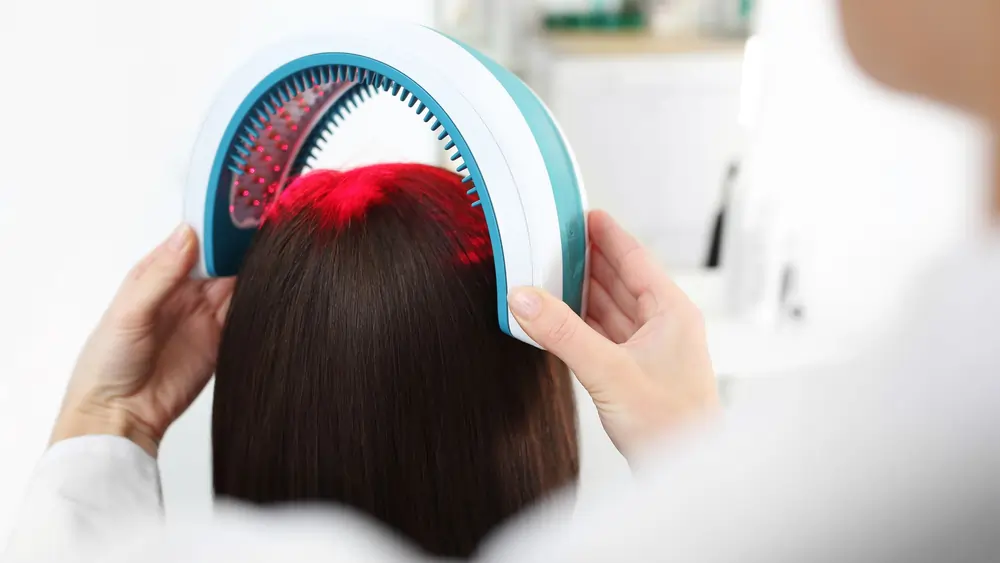The sight of receding hairlines, thinning patches, or excessive shedding can have a significant impact on one’s self-esteem and overall well-being. Understanding the early signs and causes of hair loss is crucial for timely intervention and effective management. In recent times, the emergence of hair loss tests at home has provided individuals with a convenient and accessible means to monitor their hair health.
At-Home Hair Loss Tests at Home: A New Frontier
In recent years, the landscape of hair care has evolved with the introduction of hair loss tests for home usage. These tests provide individuals with the ability to assess their hair health from the comfort of their homes, offering a proactive approach to monitoring changes and identifying potential issues early on. This article aims to explore the types of hair loss, the signs and symptoms to be aware of, traditional methods of diagnosis, and the increasing role of hair loss tests at home in empowering individuals to take charge of their hair health. Through this exploration, readers will gain valuable insights into the benefits, limitations, and practical aspects of conducting at-home hair loss tests.
Types of Hair Loss
Understanding the diverse forms of hair loss is essential for effective management and targeted intervention. Different types of alopecia present with distinct patterns and underlying causes, influencing the choice of treatment and prevention strategies.
Androgenetic Alopecia (Male and Female Pattern Baldness)
Androgenetic alopecia is the most common form of hair loss, affecting both men and women. It is hereditary and often results from a combination of genetic and hormonal factors.
In men, it typically manifests as a receding hairline and thinning at the crown, leading to eventual baldness. Women may experience diffuse thinning across the scalp. Hair loss tests at home can help monitor changes in hair density and identify early signs of androgenetic alopecia.
Telogen Effluvium
Telogen effluvium is characterized by a sudden and widespread shedding of hair. It often follows significant physiological or psychological stressors.
Signs and Symptoms are increased hair shedding, noticeable within a few months after the triggering event. At-home tests can assist in tracking changes in hair shedding patterns and identifying potential causes.
Alopecia Areata
Alopecia areata is an autoimmune condition where the immune system mistakenly attacks hair follicles, resulting in sudden hair loss. Signs of Alopecia areata are bald patches on the scalp or other areas of the body. At-home tests may aid in monitoring the extent of hair loss and assessing regrowth.
Other Causes and Contributing Hair Loss Factors
Various factors such as nutritional deficiencies, hormonal imbalances, and certain medical conditions can contribute to hair loss. Hair loss patterns may vary based on the underlying cause. Hair loss tests at home can help identify changes in hair health and guide individuals in seeking appropriate medical advice.
Signs and Symptoms of Hair Loss
Recognizing the early signs and symptoms of hair loss is crucial for initiating timely interventions and seeking appropriate care. By being vigilant about changes in hair density, texture, and overall appearance, individuals can take proactive steps to address potential issues. Here are key indicators to be mindful of:
Thinning Hair:
- Description: Gradual reduction in hair density, resulting in a visibly thinner appearance.
- Signs and Symptoms: Widening part lines, decreased coverage on the scalp, and increased visibility of the scalp through the hair.
- At-Home Observation: Regularly monitoring changes in hair thickness through hair loss tests at home, such as hair count assessments, can provide insights into the progression of thinning.
Receding Hairline:
- Description: The gradual retreat of the hairline, particularly along the forehead and temples.
- Signs and Symptoms: Formation of a distinctive “M” shape in men, and subtle changes in the hairline shape in women.
- At-Home Observation: At-home tests that focus on the examination of the frontal and temporal regions can aid in tracking changes associated with a receding hairline.
Bald Patches
- Description: Sudden and localized areas of hair loss, often circular or oval in shape.
- Signs and Symptoms: Clearly defined bald spots on the scalp or other areas of the body.
- At-Home Observation: At-home tests, such as scalp examinations and hair pull tests, can help identify the presence and extent of bald patches.
Increased Hair Shedding
- Description: Excessive hair shedding beyond the normal range.
- Signs and Symptoms: Noticing more hair in combs, brushes, or during showering. Increased hair on pillows and clothing.
- At-Home Observation: Regularly performing a hair pull test or counting the number of hairs shed during washing can assist in monitoring changes in shedding patterns.
Traditional Hair Loss Diagnosis Methods
While hair loss tests at home provide a convenient means of monitoring hair health, traditional diagnosis methods conducted by dermatologists and healthcare professionals remain integral for a comprehensive understanding of the underlying causes of hair loss. These methods involve in-depth examinations, assessments, and, when necessary, laboratory tests. Here are the primary traditional methods used for diagnosing hair loss:
Dermatologist Consultation: A thorough examination conducted by a dermatologist specializing in hair and scalp conditions. During this process, the dermatologist assesses the pattern of hair loss, examines the scalp, and may inquire about medical history and lifestyle factors. The advantages include the dermatologist’s ability to provide personalized insights, identify less common causes of hair loss, and recommend targeted treatments.
Scalp Biopsy: Involves taking a small tissue sample from the scalp for microscopic examination. This biopsy helps identify specific conditions affecting hair follicles, offering valuable information for diagnosis. The advantages of scalp biopsies lie in their ability to provide detailed insights into the cause of hair loss and guide treatment decisions.
Blood Tests: Utilizes blood tests to assess hormonal levels, nutritional deficiencies, and underlying medical conditions. Blood samples are analyzed to identify factors contributing to hair loss, such as thyroid disorders or iron deficiency. The advantages of blood tests include their ability to identify systemic issues contributing to hair loss, guiding comprehensive treatment plans.
Microscopic Hair Analysis: Involves the examination of hair samples under a microscope to assess hair shaft and follicle health. Microscopic analysis aids in diagnosing conditions like trichotillomania and provides insights into the overall health of the hair. The advantages of microscopic analysis include its capability for a detailed examination of individual hairs, aiding in the identification of specific issues affecting hair quality.
Benefits of Hair Loss Tests At Home
As technology continues to advance, hair loss tests at home have become increasingly popular, offering individuals a convenient and proactive approach to monitor their hair health. These tests come with several benefits, complementing traditional diagnosis methods and empowering individuals in their journey to address hair loss effectively.
Hair loss tests at home offer convenience, allowing individuals to monitor their hair health without frequent visits to healthcare professionals. Conducting these tests in the comfort of one’s home ensures privacy, addressing personal concerns without potential discomfort associated with clinic visits.
Early detection and intervention are facilitated through regular monitoring with at-home tests. Identifying changes promptly allows for timely action, potentially slowing down or reversing the progression of certain types of alopecia.
In terms of cost-effectiveness, hair loss tests at home are often more affordable than multiple visits to healthcare professionals for monitoring purposes. This financial accessibility makes these tests available to a broader range of individuals, encouraging proactive hair health management.
At-home tests provide a means for personalized tracking, allowing individuals to monitor changes in their hair health over time. This regular monitoring empowers individuals to take an active role in their hair care, fostering a sense of control and awareness.
Common Hair Loss Tests At Home
To empower individuals in monitoring their hair health, various at-home tests have emerged, providing accessible tools for regular assessments. These tests can be performed in the comfort of one’s home, offering insights into changes in hair density, shedding patterns, and overall scalp health. Here are some common at-home hair loss tests:
Hair Pull Test
- Description: The hair pull test involves gently tugging on a small cluster of hairs to assess the ease with which they are extracted.
- Procedure: Select a small bunch of hairs and gently pull. Increased hair shedding may indicate a potential issue.
- Interpretation: If more than a few hairs are shed during the test, it could suggest increased hair loss. However, occasional shedding is normal.
Hair Count
- Description: This test involves counting the number of hairs shed during a specified period, typically during washing or combing.
- Procedure: Collect and count hairs that are shed during a specific activity, such as washing or combing.
- Interpretation: An increase in the number of shed hairs beyond the norm may signal a potential issue with hair health.
Scalp Examination
- Description: Close examination of the scalp to identify any changes in skin color, redness, flakiness, or the presence of bald patches.
- Procedure: Use a mirror or enlist the help of a friend or family member to inspect the scalp thoroughly.
- Interpretation: Any unusual findings, such as redness or bald patches, may warrant further investigation.
DIY Scalp Analysis Tools and Apps
- Description: Various tools and mobile applications are available for assessing scalp health and monitoring hair growth.
- Procedure: Follow the instructions provided by the tool or app to capture images and assess scalp condition.
- Interpretation: These tools often use algorithms to analyze images and provide insights into scalp health, shedding, and potential issues.
How to Perform Hair Loss Tests at Home
Performing hair loss tests at home correctly is essential for obtaining accurate and meaningful results. Below, we provide a step-by-step guide for each common at-home test, along with precautions and considerations to ensure proper execution:
Hair Pull Test
- Select a small bunch of hairs: Choose a small cluster of hairs, ideally around 20-30 strands.
- Gently pull the hairs: Hold the selected hairs between your fingers and give a gentle tug.
- Observe the results: Count the number of hairs that are easily pulled out. If more than a few hairs come out, it may indicate increased shedding.
Precautions:
- Perform the test on dry, clean hair.
- Avoid vigorous pulling, as this can cause breakage.
Hair Count
- Choose a specific activity: Decide on an activity such as washing or combing to count shed hairs.
- Collect and count hairs: Collect the hairs shed during the chosen activity and count them.
- Monitor changes: Keep track of the number of shed hairs over time. A significant increase may indicate a potential issue.
Precautions:
- Ensure the hair is dry before counting.
- Be consistent in the chosen activity for accurate comparisons.
Scalp Examination
- Use a mirror: Position yourself in front of a mirror or ask for assistance to thoroughly examine the scalp.
- Look for abnormalities: Check for changes in skin color, the presence of redness, flakiness, or bald patches.
- Document findings: Take note of any unusual findings and monitor for changes over time.
Precautions:
- Adequate lighting is essential for a thorough examination.
- Be gentle to avoid causing irritation to the scalp.
DIY Scalp Analysis Tools and Apps
- Follow instructions: Adhere to the guidelines provided by the tool or app for capturing images and assessing scalp health.
- Capture images: Use the tool or app to capture images of the scalp from different angles.
- Review results: Analyze the results provided by the tool, which may include insights into hair density, scalp health, and potential issues.
Precautions:
- Ensure a stable internet connection for app-based tools.
- Follow the instructions carefully to obtain accurate results.
Regularly performing these at-home tests and documenting the results will provide individuals with a valuable baseline for monitoring changes in their hair health. However, it’s important to keep in mind that these tests are not a substitute for professional diagnosis. If concerns persist or if there are significant changes in hair health, consulting with a healthcare professional or dermatologist is advisable.
Limitations and Challenges of Hair Loss Tests at Home
While hair loss tests at home offer a convenient means of monitoring hair health, it’s crucial to recognize their limitations and potential challenges. Understanding these aspects ensures that individuals approach the results with realistic expectations and seek professional guidance when needed:
In terms of accuracy compared to professional diagnosis, at-home tests may lack the precision of methods like scalp biopsies or microscopic hair analysis. Results from at-home tests are often generalized and may not offer insights into specific underlying conditions contributing to hair loss.
Various external factors can influence at-home test results, including lighting conditions, user technique, and the quality of tools or apps used. Additionally, the accuracy of results may vary between individuals and across different testing sessions.
Knowing when to consult a healthcare professional is crucial. If at-home tests reveal consistent or worsening issues, seeking professional advice for a more in-depth diagnosis is recommended. Similarly, if individuals are uncertain about interpreting at-home test results or if results are inconclusive, consulting a healthcare professional is advisable.
Emerging Technologies in At-Home Hair Loss Testing
Advancements in technology continue to shape the landscape of at-home hair loss testing, introducing innovative solutions for monitoring and managing hair health. These emerging technologies offer enhanced precision, accessibility, and connectivity, ushering in a new era in the field. Here are some notable developments:
Smart Devices and Apps:
- Smart Microscopes: Compact and user-friendly microscopes that can be connected to smartphones for detailed scalp and hair analysis.
- Hair Analysis Apps: Mobile applications equipped with advanced algorithms for analyzing images of the scalp, providing insights into hair health and potential issues.
- Wearable Devices: Smart hairbrushes and combs embedded with sensors to track hair quality, breakage, and overall health.
Advances in Hair Analysis Technology:
- DNA Testing for Hair Health: Genetic testing services that offer insights into an individual’s genetic predisposition to certain types of hair loss.
- Real-Time Monitoring: Devices that continuously monitor factors such as hair growth rate, thickness, and density, providing real-time data for users.
Telemedicine for Remote Consultations:
- Virtual Dermatology Consultations: Platforms that enable individuals to consult with dermatologists remotely for hair health assessments.
- Telehealth Apps: Mobile applications that facilitate virtual consultations, allowing healthcare professionals to provide personalized advice and treatment plans.
Hair Loss Tests at Home: Conclusion
In conclusion, the advent of hair loss tests at home represents a significant leap in personalized health monitoring, offering individuals a proactive approach to understanding and managing their hair health. These tests provide a convenient and private means for regular monitoring, enabling early detection and intervention in the ever-evolving landscape of hair care.
While at-home tests offer valuable insights, it’s essential to recognize their limitations and view them as complementary to professional diagnosis methods. Emerging technologies, including smart devices, advanced analysis tools, and telemedicine, further enhance our ability to monitor and address hair health effectively.
Balancing at-home testing with lifestyle considerations, proper care routines, and stress management establishes a holistic approach to maintaining healthy hair. The synergy between at-home tools and professional guidance promises a more informed and empowered future in the dynamic realm of hair care. By adopting these strategies, individuals can embark on a journey toward healthier, more resilient hair, fostering confidence and well-being.




